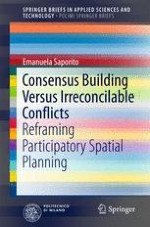2016 | OriginalPaper | Chapter
4. Rationalities at Work: How to Read the PII Isola Participatory Process Through Three Different Conceptual Models
Author : Emanuela Saporito
Published in: Consensus Building Versus Irreconcilable Conflicts
Publisher: Springer International Publishing
Activate our intelligent search to find suitable subject content or patents.
Select sections of text to find matching patents with Artificial Intelligence. powered by
Select sections of text to find additional relevant content using AI-assisted search. powered by
